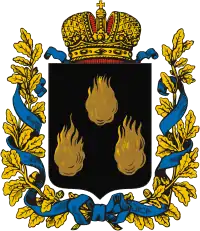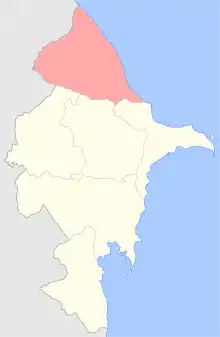Kuba Uyezd
Kuba Uyezd (Russian: Кубинский уезд, Azerbaijani: Quba qəzası) was an administrative unit within the Baku Governorate of Russian Empire and then of Azerbaijan Democratic Republic and Azerbaijan SSR with its center in the city of Quba until its formal abolition in 1929 by Soviet authorities. The uyezd was located in northern part of the Baku Governorate, bordering Caspian sea to the east, Elisabethpol Governorate to the west, Dagestan Oblast to the north, Geokchai, Shamakhi and Baku uyezds to the south.[1]
Kuba Uyezd
Кубинский уезд | |
|---|---|
 Coat of arms | |
 | |
| Country | Russian Empire |
| Political status | Uyezd |
| Governorate | Baku |
| Established | 1840 |
| Abolished | 1929 |
| Area | |
| • Total | 6,704 km2 (2,588 sq mi) |
| Population (1926) | |
| • Total | 189,916 |
| • Density | 28/km2 (73/sq mi) |
Geography
Uyezd was located on the northern slope of the eastern part of Greater Caucasus mountain range, mainly consisting of 3 main parts: Mountains, which occupies most parts of the south-west, foothills, covering most of the uyezd from southwest to northeast, and lowlands, mostly in the areas bordering the Caspian sea. The highest point in the uyezd, Shahdagh, is located at the western part of the uyezd at 13,951 feet.[2]
The three main rivers in the uyezd were Qudyal, Gilgil and Qusarchay. The Samur river formed the northern border.[2]
History
After the capture of the Quba Khanate by the Russian forces in 1806, during the Caucasus Campaign, the khanate was removed and was made a province of the Russian Empire. The uyezd was created in 1840 and was initially made part of the Caspian Oblast in the same year, and later part of the Shamakhi Governorate in 1846. Due to an earthquake in Shamakhi in 1859, the centre of the Shamakhi Governorate was moved from Shamakhi to Baku and the governorate was renamed Baku Governorate.[3]
In 1918, after the collapse of the Russian Empire, Azerbaijan became part of Transcaucasian Democratic Federative Republic. After the establishment of the Baku Commune in April 1918,[4] clashes began in the city of Baku and other uyezds within the Baku Governorate,[5] called the March Days, during which 12,000 Azerbaijanis and other Muslims and 2,500 Armenians died.[6][7][8]
On 28 May 1918, the Azerbaijan Democratic Republic declared its independence and the uyezd was kept as part of its administrative units. After the Red Army invasion of Azerbaijan in 1920, Azerbaijan was integrated into the Soviet Union and the uyezd was abolished by Soviet authorities in 1929.
Population
According to the 1897 Russian Empire census, 183,242 people inhabited the uyezd, of which 15,363 lived in the city of Quba. The census recorded 70,150 native speakers of Azerbaijani, 46,430 speakers of Tat language, 44,755 speakers of Lezgian, 3,972 speakers of Judeo-Tat and 3,971 speakers of Russian.[9]
The population rose to 189,916 people, of which 17,902 were urban and 172,014 rural.[10]
References
- Tsutsiev, Arthur (2014). Atlas of the Ethno-Political History of the Caucasus. Translated by Nora Seligman Favorov. New Haven: Yale University Press. p. 59. ISBN 9780300153088.
- "Большой энциклопедический словарь Брокгауза и Ефрона. Агдаш" [Brockhaus and Efron Encyclopedia Dictionary. Kuba]. Retrieved 2011-08-05.
- "Administrative Territorial Division" (PDF). preslib.az. p. 9.
- Hopkirk, Peter. On Secret Service East of Constantinople: The Plot to Bring Down the British Empire, Oxford University Press, 2001; ISBN 0-19-280230-5, pp 304–5, 322
- Shahumyan, Stepan (1959). Letters 1896–1918. Yerevan: State Publishing House of Armenia. pp. 63–67.
On one side were fighting the Soviet Red Guard; the Red International Army, recently organized by us; the Red Fleet, which we had succeeded in reorganizing in a short time; and Armenian national units. On the other side the Muslim Savage Division in which there were quite a few Russian officers, and bands of armed Muslims, led by the Musavat Party... For us the results of the battle were brilliant. The destruction of the enemy was complete... More than three thousand were killed on both sides
- Pasdermadjian, Garegin (1918). Why Armenia Should be Free: Armenia's Role in the Present War. The Armenian National Union of America. pp. 188–199.
- Minahan, James B. (1998). Miniature Empires: A Historical Dictionary of the Newly Independent States. p. 22. ISBN 0-313-30610-9.
The tensions and fighting between the Azeris and the Armenians in the federation culminated in the massacre of some 12,000 Azeris in Baku by radical Armenians and Bolshevik troops in March 1918
- Michael Smith. "Pamiat' ob utratakh i Azerbaidzhanskoe obshchestvo/Traumatic Loss and Azerbaijani. National Memory". Azerbaidzhan i Rossiia: obshchestva i gosudarstva (Azerbaijan and Russia: Societies and States) (in Russian). Sakharov Center. Retrieved 21 August 2011.
- "Population of Kuba Uyezd (1897)". Demoskop Weekly (in Russian).
- "Population of Kuba Uyezd". Demoskop Weekly.